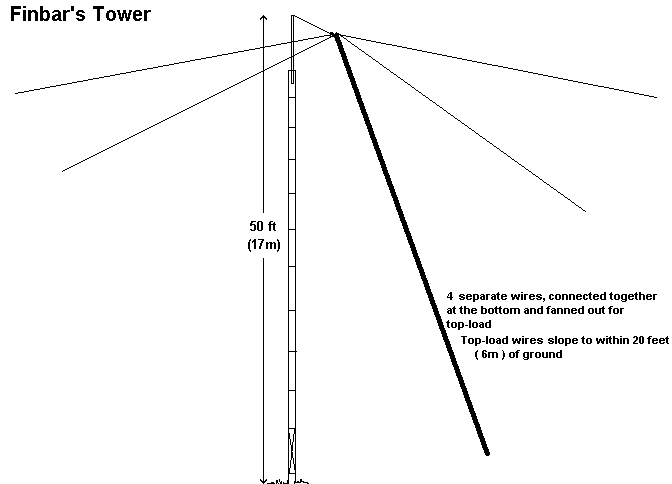
Experiments with a Tower supported Umbrella Aerial
Alan Melia (G3NYK) and Finbar O’Connor (EI0CF)
After the interesting results on the top-loaded Spiral Aerials, Finbar determined to experiment further with his main top loaded tower supported aerial. This is in the form of an umbrella with the top load wires sloping from the apex which is pulled away from the tower. Finbar has a loop aerial which he uses as a directional RX aerial. The apex of the triangular loop is supported part way up the tower, and being beneath the main aerial top load wires it becomes ‘part’ of the main aerial system. As a side effect Finbar was able to measure the effects of the loop on the main aerial system and determine the best arrangement to reduce the interaction.

The initial configuration consisted of two insulated wires connected together at the feed point then run up to the tower support which consisted of a running insulator. The top wires where then spread, and sloped down to supports anchored in nearby trees. Measurements were made with two, four, and finally five ‘umbrella’ wires. The improvement in aerial capacity was quite significant increasing from about 550pF for 2 wires to over 1000pF for 5 wires with the ends conneted in 'bow-tie' fashion.. Whilst the addition of extra earthing rods in the sea shore made minor differences to the loss resistance the increase in capacity reduced the loss to half. At this point the deployment of radials or counterpoises under the top wires seemed to make very little difference. That may be explained by the relatively good conductivity of the ground at Finbar’s location on the sea-shore. What we have not tired is rolling out the 'counterpoise wires, and then earth (grounding) them under the end of the umbrella wires (see the article in Appendix 1 of the new LF Experimenter's Handbook by Meissner dated 1922)
The capacity and loss values measured for these configurations have been transferred to the plot of Loss v Capacity on the main page of the Spiral Top-loaded Aerial page. The values seem to follow the same relationship as was found with the spiral aerials (thanks to Alexander Yurkov, RA6MB, for the ideas on that) The remaining uncertainty is the effect of the tower which is unavoidably grounded via its mounting post. Maybe we should try the feed system described in Rik Strobbe's (ON7YD) tutorial on LF aerials. (Link elsewhere on these pages)
(I believe the configuarations described are correct but Finbar had a computer crash and I have not be able to correspond with him to check my descriptions)
click here for measurement page